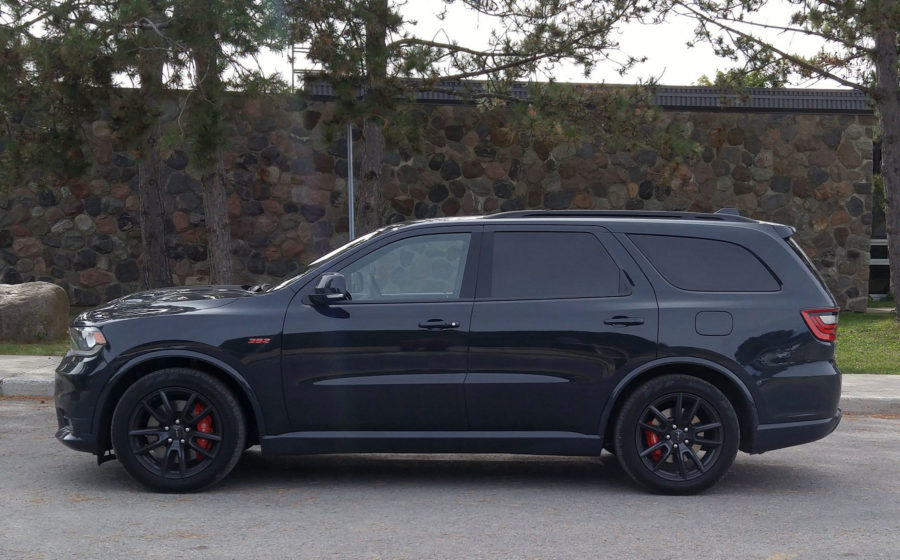The hard part about reviewing yet another SUV is figuring out what makes it stand out in a marketplace full of them. SUVs and crossovers are the current darlings of family transportation. Deciding what makes one vehicle better for that purpose than another can be a challenge, even for an experienced car reviewer.
But that task is made a lot easier when it comes to the Dodge Durango SRT, a hot-rod version of the brand’s mid-size SUV. The Durango starts out with mainstream V6 and V8 engines. However, the SRT uses a big 6.4L V8 with 475 hp and 470 lb-ft of torque.
Performance
The Dodge Durango SRT isn’t the first performance SUV from parent company Fiat Chrysler Automobiles. The Jeep Grand Cherokee SRT is the original, and the Durango SRT shares its engine with that Jeep. Dodge also uses this engine in the Challenger and Charger cars.
- Acceleration: This is a lot of power, even for an SUV at the large end of the mid-size class. Acceleration is thrilling for the driver and great for surprising unsuspecting passengers. It comes with a juicy exhaust note, too.
- Handling:Dodge also designed the Durango SRT for good handling. It’s as much fun to hustle around a racing circuit as it is to haul down a drag strip. That handling prowess comes at the expense of ride comfort, with suspension that feels harsh on city streets.
- Braking: Stopping is just as important as accelerating in a vehicle with nearly 500 hp. The Dodge Durango SRT has strong Brembo brakes that boast reassuring stopping power.
- Fuel economy: This is the elephant in the room when talk turns to performance SUVs. Unsurprisingly, the SRT is the least-efficient version of the Durango. However, Dodge’s fuel consumption estimates of 18.3/12.2 L/100 km (city/highway) are not a lot worse than those for lesser Durango models with the 5.7L V8.
Despite the 6.4L engine’s fuel-saving cylinder deactivation system, our test vehicle averaged more than 20.0 L/100 km in city driving.
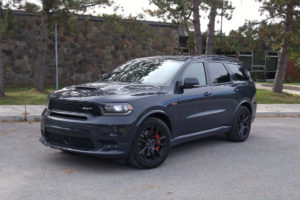
Utility
- Three-row seating: The Durango is similar to the Jeep Grand Cherokee, but its larger body allows for a third row of seating. The space back there is generous enough to be useful, but Dodge accomplished that by stealing some legroom from the second row. Keep in mind the Durango SRT has standard second-row captain’s chairs, so it’s only a six-seater. The most potent seven-seat version is the 360-hp R/T.
- Cargo space: As in most three-row, mid-size SUVs, there’s a modest amount of luggage room behind the third row. Of course, the two rear-most seats do fold away, creating a very useful cargo area.
- Towing capacity: On top of being the most potent Durango variant, an optional towing package gives the SRT the most robust tow rating, at nearly 4,000 kg. The Durango SRT’s toughened-up eight-speed transmission and those Brembo brakes contribute to that capability.
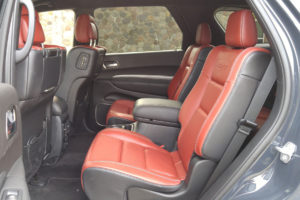
Technology
- Infotainment: The Durango SRT comes with an 8.4-inch touchscreen and the well-done Uconnect infotainment system. It contains the main controls for navigation, audio and climate systems. Some climate controls are duplicated with hard buttons below the screen, but we wish those included the heated seats and steering wheel. However, those are the first things that appear on the screen every time you start the engine, a thoughtful touch.
- Digital gauge cluster: The Dodge Durango SRT has a partial LCD gauge cluster that places a tachometer and digital speedometer front and centre. It can be set to display a variety of information, like fuel economy and speed limits, both of which are very useful in this truck.
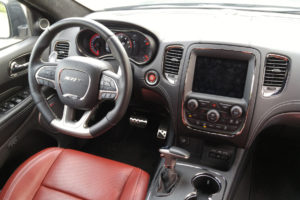
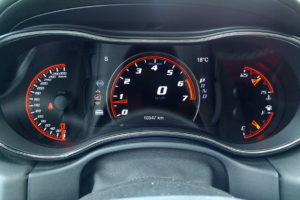
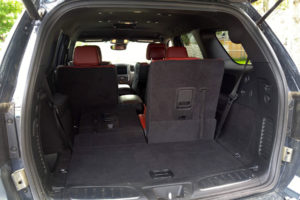
Pricing, value and competition
The Durango SRT carries an MSRP of nearly $74,000, or about $15,000 more than the R/T model. That seems like a lot of money for an extra 115 hp and 80 lb-ft of torque.
Dodge fitted our test vehicle with a leather-trimmed dash and carbon fibre trim for $3,250, and a technology bundle (adaptive cruise control, forward-collision warning with automatic braking and lane-departure alert with lane-keep assist) for $950. Those extras turned our Durango SRT into a roughly $78,000 vehicle.
Here’s some perspective: The Jeep Grand Cherokee SRT goes for a bit less than $77,000. There’s also a Trackhawk version with 707 hp for $112,000. A Porsche Cayenne S with 434 hp costs more than $92,000, and the 541-hp Cayenne Turbo is $140,000. The BMW X5 is closer to the Dodge’s MSRP at $86,000 for the 456-hp xDrive50i version.
But those three vehicles are five-seaters. Mercedes-Benz’s three-row GLS 550 makes 449 hp for nearly $111,000. If you want to get really serious, the Mercedes-AMG GLS 63 makes 577 hp for $140,000. Those Mercedes machines aren’t built for track handling the way the Durango SRT, Grand Cherokee SRT and Cayenne are.
Conclusion
If your goal is to move six people while scaring the bejeezus out of them, there are not many vehicles that will do it better than the Dodge Durango SRT.
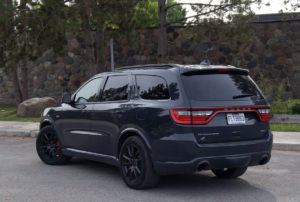
If don’t need three rows of seating, the Jeep Grand Cherokee SRT projects a more upscale image at a similar MSRP. And if the Durango SRT’s performance seems like overkill, the R/T model is still a strong performer with a smoother ride and a more accessible price.
2019 Dodge Durango SRT
- Vehicle category: Mid-size SUV/crossover
- Engine: 6.4L V8, 475 hp, 470 lb-ft torque
- Transmission: 8-speed automatic
- Notable standard features (base model; MSRP: $73,895): Auto-dimming rearview mirror and driver’s side mirror, HID headlights and LED fog lights, power-adjustable steering wheel, passive keyless entry, ventilated front seats.
- Notable options (as tested MSRP: $78,095): Leather-trimmed dash, carbon fibre interior trim, $3,250; Tech package: Adaptive cruise control, forward-collision warning with automatic braking and lane-departure alert with lane-keep assist, $950).
- Fuel economy, ratings (l/100km, city/highway): 18.3/12.2
- Fuel economy, observed (l/100km): 21.0


